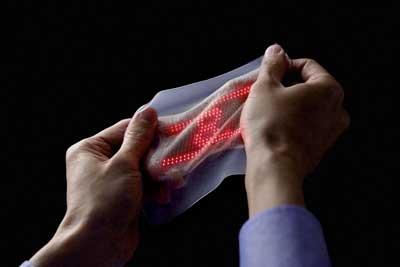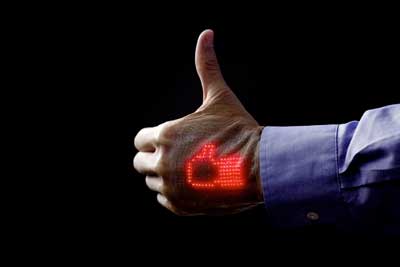| Posted: Feb 19, 2018 |
Ultrathin, highly elastic skin display shows electrocardiogram readings
(Nanowerk News) A new ultrathin, elastic display that fits snugly on the skin can show the moving waveform of an electrocardiogram recorded by a breathable, on-skin electrode sensor. Combined with a wireless communication module, this integrated biomedical sensor system - called "skin electronics" - can transmit biometric data to the cloud.
|
|
This latest research by a Japanese academic-industrial collaboration, led by Professor Takao Someya at the University of Tokyo's Graduate School of Engineering, is slated for a news briefing and talk ("Continuous Health-Monitoring With Ultraflexible On-Skin Sensors)" at the AAAS Annual Meeting in Austin, Texas on February 17th.
|
 |
| The soft, flexible skin display is about 1 millimeter thick, and consists of a 16 x 24 array of micro LEDs and stretchable wiring mounted on a rubber sheet. It can withstand repeated stretching, by as much as 45 percent of its original length, without showing any loss in function of its electrical and mechanical properties. (Image: Takao Someya Research Group)
|
|
Thanks to advances in semiconductor technology, wearable devices can now monitor health by first measuring vital signs or taking an electrocardiogram, and then transmitting the data wirelessly to a smartphone. The readings or electrocardiogram waveforms can be displayed on the screen in real time, or sent to either the cloud or a memory device where the information is stored.
|
|
The newly-developed skin electronics system aims to go a step further by enhancing information accessibility for people such as the elderly or the infirm, who tend to have difficulty operating and obtaining data from existing devices and interfaces. It promises to help ease the strain on home healthcare systems in aging societies through continuous, non-invasive health monitoring and self-care at home.
|
|
The new integrated system combines a flexible, deformable display with a lightweight sensor composed of a breathable nanomesh electrode and wireless communication module. Medical data measured by the sensor, such as an electrocardiogram, can either be sent wirelessly to a smartphone for viewing or to the cloud for storage. In the latest research, the display showed a moving electrocardiogram waveform that was stored in memory.
|
|
The skin display, developed by a collaboration between researchers at the University of Tokyo's Graduate School of Engineering and Dai Nippon Printing (DNP), a leading Japanese printing company, consists of a 16 x 24 array of micro LEDs and stretchable wiring mounted on a rubber sheet.
|
|
"Our skin display exhibits simple graphics with motion," says Someya. "Because it is made from thin and soft materials, it can be deformed freely."
|
|
The display is stretchable by as much as 45 percent of its original length.
|
|
It is far more resistant to the wear and tear of stretching than previous wearable displays. It is built on a novel structure that minimizes the stress resulting from stretching on the juncture of hard materials, such as the micro LEDs, and soft materials, like the elastic wiring - a leading cause of damage for other models.
|
 |
| An integrated "skin electronics" system allows health monitoring at home and gives doctors remote access to biometric data transmitted wirelessly to a medical cloud. It promises to enhance self-care and accessibility of medical information to various segments of the population, including children and the elderly. A thumbs-up image on the skin display serves as an indicator of good health. (Image: Takao Someya Research Group)
|
|
It is the first stretchable display to achieve superior durability and stability in air, such that not a single pixel failed in the matrix-type display while attached snugly onto the skin and continuously subjected to the stretching and contracting motion of the body.
|
|
The nanomesh skin sensor can be worn on the skin continuously for a week without causing any inflammation. Although this sensor, developed in an earlier study, was capable of measuring temperature, pressure and myoelectricity (the electrical properties of muscle), it successfully recorded an electrocardiogram for the first time in the latest research.
|
|
The researchers applied tried-and-true methods used in the mass production of electronics - specifically, screen printing the silver wiring and mounting the micro LEDs on the rubber sheet with a chip mounter and solder paste commonly used in manufacturing printed circuit boards. Applying these methods will likely accelerate the commercialization of the display and help keep down future production costs.
|
|
DNP is looking to bring the integrated skin display to market within the next three years by improving the reliability of the stretchable devices through optimizing its structure, enhancing the production process for high integration, and overcoming technical challenges such as large-area coverage.
|
|
"The current aging society requires user-friendly wearable sensors for monitoring patient vitals in order to reduce the burden on patients and family members providing nursing care," says Someya. "Our system could serve as one of the long-awaited solutions to fulfill this need, which will ultimately lead to improving the quality of life for many."
|


